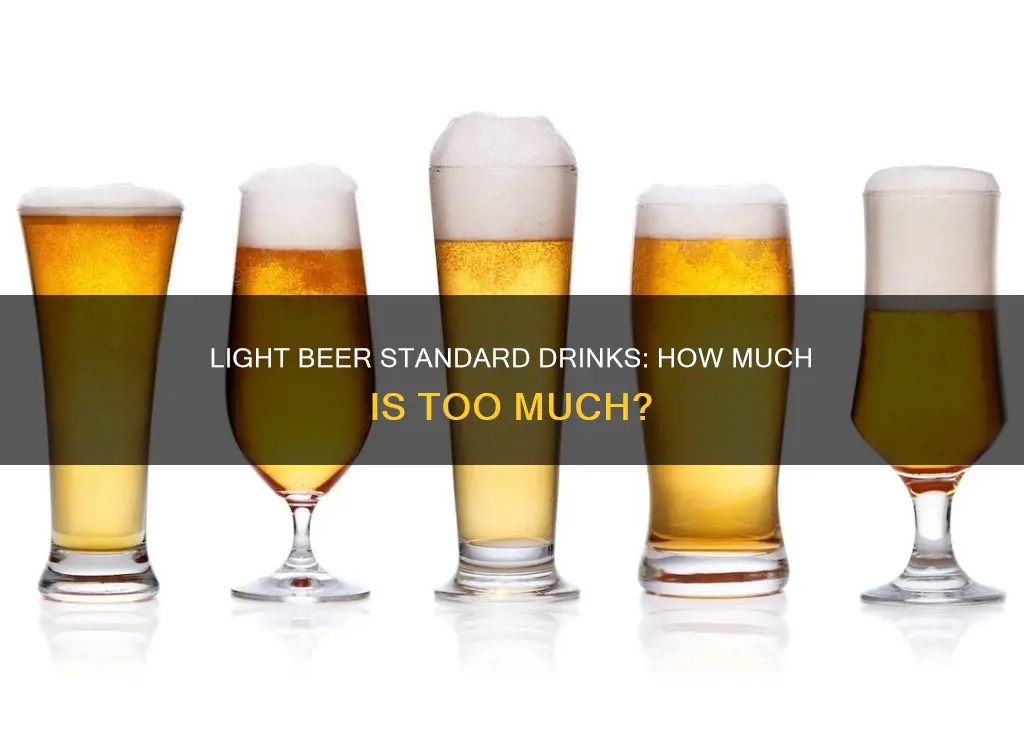
The amount of liquid in your glass of beer does not necessarily reflect its alcohol content. Light beers, for example, can have nearly as much alcohol as regular beers, with an average alcohol content of 4.2% compared to 5% for regular beers. In the United States, a standard drink is defined as containing roughly 14 grams of pure alcohol, which is found in 12 ounces of regular beer. However, the definition of a standard drink varies across countries, with values ranging from 8 to 20 grams. In Australia, a 375ml can of full-strength beer (4.8% alcohol) is equivalent to 1.4 standard drinks, while in the UK, a pint of beer at 4% ABV contains 2.3 units of alcohol.
| Characteristics | Values |
|---|---|
| Amount of liquid | 12 ounces |
| Alcohol content | 5% |
| Amount of pure alcohol | 0.6 ounces (14 grams) |
What You'll Learn

Light beer vs. regular beer alcohol content
In the United States, a standard drink is defined as any beverage containing 0.6 fl oz or 14 grams of pure alcohol. This is roughly equivalent to 12 ounces of regular beer, which is usually about 5% alcohol. However, the percentage of pure alcohol varies within and across beverage types.
Light beers are the best-selling beers in the U.S. and typically contain fewer calories and less alcohol than regular beers. The term "light" in light beer generally refers to a beer with fewer calories and, consequently, less alcohol, as most of the calories in beer come from alcohol. For example, Budweiser contains 146 calories and has an ABV of 5%, while Bud Light contains 110 calories and 4.2% ABV.
While regular beers often have around 5% ABV, most light beers sold in America have approximately 4.2% ABV. However, it's important to note that the alcohol content of light beers can vary, and in some cases, they may have almost as much alcohol as regular beers – about 85% ABV.
In other parts of the world, such as Scotland and Australia, the term "light beer" refers to beers with only 3.2% ABV. Additionally, the definition of a standard drink differs in Australia, where it is defined as containing 10 grams of pure alcohol.
Blood Thinners and Beer: Is It Safe to Mix?
You may want to see also

How to calculate pure alcohol content
In the US, a standard alcoholic drink is defined as any beverage containing 0.6 fluid ounces (fl oz) or 14 grams of pure alcohol. This is also known as a drink equivalent. However, the percentage of pure alcohol or alcohol by volume (ABV) varies across beverage types and brands.
For example, a standard drink of beer is typically defined as 12 fluid ounces with 5% ABV. However, light beers may have a lower ABV of 4.2%. This means that a light beer with 4.2% ABV is 0.85 standard drinks (or drink equivalents).
To calculate the pure alcohol content in grams, you can use the following formula:
> Pure alcohol in grams = Volume in milliliters (ml) x ABV% / 100
For instance, a 355ml can of beer with 5% ABV would contain 17.75 grams of pure alcohol (355 x 5 / 100 = 17.75).
Alternatively, you can calculate the alcohol by volume (ABV) using a hydrometer or a refractometer. A hydrometer measures the density of a liquid, and the change in density before and after fermentation can be used to calculate the ABV. A refractometer measures the concentration of substances dissolved in a liquid by measuring how light refracts when it passes through.
> ABV% = (Original Gravity - Final Gravity) x 131.25
Where:
- Original Gravity (OG) is the density of the beer before fermentation
- Final Gravity (FG) is the density of the beer after fermentation
Beer After Hernia Surgery: What You Need to Know
You may want to see also

How to calculate standard drinks in a serving
The amount of liquid in your glass, can, or bottle does not necessarily correspond to the amount of alcohol it contains. Different types of beer, wine, or malt liquor can have very different alcohol content. For example, many light beers have nearly as much alcohol as regular beer, about 85% as much.
In the United States, one "standard" drink (or one alcoholic drink equivalent) contains about 14 grams of pure alcohol, which is found in:
- 12 ounces of regular beer, which is usually about 5% alcohol
- 5 ounces of wine, which is typically about 12% alcohol
- 1.5 ounces of distilled spirits, which is about 40% alcohol
In other words, a standard drink in the US is defined as any beverage containing 0.6 fl oz or 14 grams of pure alcohol. The percentage of pure alcohol, or alcohol by volume (alc/vol), varies within and across beverage types.
In Canada, a standard drink contains 17.05ml or 0.6001 Imperial fluid ounces or 0.5765 US fluid ounces of pure ethanol. As there is no accepted international definition for a "standard drink", the definition varies widely from country to country.
In Australia, a standard drink is always equal to 10 grams of pure alcohol.
To calculate how many standard drinks are in a container, you need to know two things: the volume (typically shown as ounces or ml) and the alcohol by volume (typically shown as % ABV or ‘proof’).
Beer and Doxycycline: Is It Safe to Mix?
You may want to see also

How to calculate standard drinks in a container
In the United States, a standard alcoholic drink equivalent or standard drink contains roughly 14 grams of pure alcohol. This is equivalent to 12 ounces of regular beer, 5 ounces of wine, or 1.5 ounces of distilled spirits or liquor.
However, the amount of alcohol in a drink varies depending on the type of beverage and its percentage of alcohol by volume (ABV). For instance, a standard drink of light beer, which typically has an alcohol content of 4.2%, may be smaller than a standard drink of regular beer, which usually contains 5% alcohol.
To calculate the number of standard drinks in a container, you can use an online calculator or perform a manual calculation. Here's a step-by-step guide:
- Determine the Alcohol Content: Find out the percentage of alcohol by volume (ABV) or proof of the beverage. This information is typically found on the container label, especially for wine and distilled spirits. If it's not available, search online for the beverage bottler or other reliable sources.
- Use an Online Calculator: There are online calculators, such as the Alcohol Drink Size Calculator provided by the National Institute on Alcohol Abuse and Alcoholism (NIAAA), that can help you determine the number of standard drinks in a container. Input the alcohol content (ABV or proof) and the container size, and the calculator will do the rest.
- Manual Calculation: Alternatively, you can calculate the number of standard drinks manually. First, convert the container size to fluid ounces (if it's not already in ounces). Then, divide the fluid ounces by the standard drink size in ounces. For example, if you have a 12-ounce beer, you divide 12 by the standard drink size of 5 ounces, resulting in 2.4. This means your 12-ounce beer contains approximately 2.4 standard drinks.
- Consider Variability: Keep in mind that alcohol content can vary within beverage types. The standard drink amounts are meant as a guide for following health guidelines, but they may not always align with customary serving sizes.
By following these steps and using the provided resources, you can calculate the number of standard drinks in a container of beer, wine, or liquor. This knowledge can help you make informed decisions about your alcohol consumption and understand how much alcohol you're actually consuming.
Antibiotics and Alcohol: Safe Mix When Treating Chlamydia?
You may want to see also

How to calculate blood alcohol content
The amount of liquid in a glass, can, or bottle does not necessarily correspond to the quantity of alcohol it contains. For instance, some light beers have nearly as much alcohol as regular beer, with regular beer containing 5% alcohol and some light beers containing 4.2%. In the United States, one "standard" drink contains about 14 grams of pure alcohol, which can be found in:
- 12 ounces of regular beer, which is usually about 5% alcohol
- 5 ounces of wine, which is typically about 12% alcohol
- 1.5 ounces of distilled spirits, which is about 40% alcohol
To calculate blood alcohol content (BAC), you can use the simplified version of the Widmark formula: BAC = [Alcohol consumed in grams / (Body weight in grams x r)] x 100. In this formula, “r” is the gender constant: r = 0.55 for females and 0.68 for males.
- Count the number of drinks. To be as precise as possible, the number of drinks counted should be based on a standard drink size and alcohol content, as the volume and content of drinks vary widely.
- Find the alcohol dose. Once you have the number of standard drinks consumed, multiply that number by the number of grams of alcohol in a standard drink in your region to derive the alcohol dose in grams.
- Take your body weight in grams and multiply it by the gender constant. If you know your body weight in pounds, you can use the following formulas to convert it to grams: Body weight in pounds / 0.0022046 = body weight in grams or Body weight in pounds x 454 = body weight in grams.
- Divide the alcohol consumed in grams by the product of your body weight in grams and the gender constant.
- Multiply the result by 100. This will give you your BAC as a percentage.
- Account for elapsed time. If you have been drinking over a period of time, you will need to account for the time that has passed and the amount of alcohol that your body has already metabolized. To do this, use the following formula: BAC as a percentage – (elapsed time in hours x 0.015).
It is important to note that the Widmark formula is only a rough indicator of BAC and tends to underestimate the actual BAC. Additionally, no formula for calculating BAC is as accurate as an actual measured test.
Gluten-Free Beer: Is Glutenberg Safe for Celiacs to Drink?
You may want to see also
Frequently asked questions
In the US, one standard drink is 12 ounces of light beer, which typically has an alcohol content of 4.2%.
In Australia, one standard drink is a 375ml can of light beer (2.7% alcohol).
In the UK, a half-pint of beer (280ml) with 3.5% ABV is almost exactly one standard drink.
In Bosnia and Herzegovina, one standard drink is a 341ml bottle of 5% beer.







